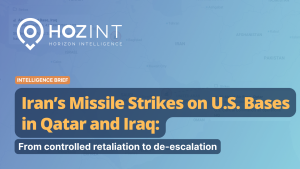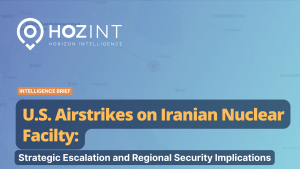After months of preparations in Tunis and several attempts, the UN-backed Presidential Council of the Libyan Government of National Accord (GNA) arrived to the capital Tripoli on 30 March 2016. The International Community supported the action as a first step in a long peace process to establish a strong and legitimate political authority in the country, and most importantly to deal with the biggest challenge to Tripoli and the region: a growing threat posed by the Islamic State (IS) group. The UN-backed GNA is conducting a large military operation to liberate Sirte from IS control. This operation signals to the West the need to help Tripoli consolidate its political and military power within the country. However, the rivalry with the forces loyal to the Tobruk based House of Representatives (HoR) is undermining the operation. Hafter’s National Libyan Army forces are preparing a new offensive against the Derna Mujahedeen Council in Eastern Libya, which means that Tobruk based HoR sees the consolidation of its political power and territorial gains as a higher priority than the fight against IS. As a result, IS is trying to exploit the situation in its favor by conducting assaults against the advancing forces around Sirte and preparing an exit plan to its leadership and main forces to the Fezzan region in southeastern Libya.
Key observations
- Rival militias loyal to the two governments, GNA and HoR, are preparing competing military campaigns to take Sirte back from the Islamic State (IS). This is in order to consolidate their positions in any future power sharing negotiations as legitimate and effective forces in the war against terror in Libya. As a result, the Sirte operation could turn from a competition to liberate Sirte into a possible confrontation between the two forces.
- Despite the urgent need of international assistance to counter IS and the existence of the Government of National Accord in Tripoli, Libya is far from unified against the IS threat. Political and tribal rivalries continue to divide the country.
- Increased attacks from IS against oil fields depicts the group’s intention to destroy the oil and gas sector. IS cannot replicate the control and benefits of the oil infrastructure they had in Syria and Iraq. The group does not have the human resources to control and use vast oil fields in Libya and the markets are too far away. Despite losing control of Ajdabia in March 2016, IS still poses a serious threat to eastern oil installations from its bases in Sirte and its region including Bin Jawwad, Hawara and Nawfaliyyah.
- The purpose of IS withdrawal from Derna after intense fighting with the Derna Mujahedeen Shura Council (DMSC) and the Libyan National Army (LNA), is to consolidate and prepare the group’s forces to defend Sirte and the territory it controls. At the same time, IS is conducting mass casualty attacks against GNA forces to undermine their assault to retake Sirte.
- The relatively peaceful arrival of the National Accord Government Presidential Council to Tripoli and the discussions it has with Central Bank of Libya (CBL) and National Oil Corporation (NOC) to integrate them under its authority, represents a first step toward a removal of the UN Security Council sanctions on Libya to gain access to USD 67 billion of frozen assets.
Key events
- On April 20, Libyan military officials announced that IS has retreated from their positions around the port city of Derna. Military spokesman Abdulkarim Sabra stated that IS has retreated from Derna’s 400 neighborhood and the district of al-Fatayeh, 20 km south of the city. Militants were reportedly intercepted by Libyan troops as they attempted to reach the IS stronghold of Sirte. Sabra confirmed that airstrikes were providing cover for ground troops. Eastern military forces are also fighting IS militants in Benghazi, liberating several neighborhoods in recent days.
- On April 23, a convoy of Islamic State terrorists attacked oil ports near Brega terminal, killing 1 guard and wounding 4, including the leader of the Petroleum Facilities Guard (PFG) Ibrahim Jathran. The fight broke out 52 km south of the Brega oil terminal.
- On April 25, Libyan Presidential Council of the National Reconciliation Government issued a statement that warns of other possible terrorist attacks against oil installations. The statement called upon the security forces guarding the country’s oil installations to take all necessary measures to counter these threats. The Council also requested assistance from the international community and the United Nations Security Council to protect oil fields and installations from falling into the hands of terrorist organizations.
- On May 13, the Government of National Accord’s (GNA) military operation against the Islamic State announced that their forces were advancing towards Abu Grein in the region between Misrata and Sirte provinces. The Libyan Army reported that their troops were approaching the Abu Grein checkpoint with caution after an IS suicide attack against at Al Sadada that left 4 soldiers dead and 30 wounded.
- On May 16, the meeting of Vienna to support security and stability in Libya issued a joint communique announcing that the UN arms embargo will be partially lifted to aid the GNA’s fight against the Islamic State. The joint statement says that the international community is ready to fully support Libya’s call for receiving assistance in their fight against IS in the form of training and equipment. However, the statement points out that the arms embargo will be only partially lifted to prevent weapons from falling in the hands of rival militias and extremists.
- On May 18, Mohammed al Gasria, a spokesman for the Libyan unity government army, announced that after fierce clashes, Abu Grain and two neighboring villages, Abou Nadjaïm and Zamzam, have been recaptured. After taking control of the coastal city of Sirte last year, IS has made multiple attempts at expanding their territory. The group captured Abu Grain and several surrounding villages in a series of suicide attacks in the region on May 5.
- On May 18, the Government of National Unity (GNA) announced that 18 government fighters were killed in clashes with IS and from a car bombing near the IS stronghold of Sirte. According to the military official, 7 fighters were killed in a car bomb attack in Buairat el-Hassun, 60 km west of Sirte. A further 11 were killed in clashes around Abu Grein, 138 km west of Sirte.
Analysis
The battle for Sirte and the political competition for influence
Despite the return of the Presidential Council of the Government of National Accord (GNA) to Tripoli on March 30 and the international community’s support, the GNA still has a significant amount of work to do to consolidate power over the country and bring national institutions under its authority. However, the primary task for the new political leadership in Tripoli is to defeat the Islamic State and eliminate its ability to control territory and plan attacks in Libya and abroad. At the same time to benefit from more western military and international support to extend its influence to the east, inside the region under the Tobruk-based House of Representatives control.
Until recently, Gen. Khalifa Haftar’s Libyan National Army focused on eastern Libya around Derna, Benghazi and Ajdabiya and on making progress in clearing out Al-Qaeda and Islamic State affiliated groups. Now, however, Haftar’s Army is shifting more forces to the west and more particularly to Sirte. On April 23, reports said that Haftar’s forces received a weapon arsenal and 600 armored vehicles from Emirati and Saudi allies that arrived via the Tobruk port to prepare the for campaign against the Islamic State in Sirte. Furthermore, militias from the Tebu, Tuareg and Magraha tribes in the south, under the command of Colonel Bin Nayel, a former Quadhafi military Commander, is reported to be preparing to join Haftar’s operation.
In other words, Haftar’s preparations to take Sirte aims to prove that he is crucial to any anti-IS operations as a means to consolidate his power in the new unity government.
Meanwhile, on April 26, militias from Misrata, loyal to the GNA in Tripoli, gathered under the Misrata Military Council and moved east toward Sirte to take up positions in Abu Grein and Zamzam crossing. The Misratan militias fear that their role in any new unity government deal would be reduced if Haftar’s forces succeed in pushing IS out of Sirte and take a key city close to Misrata. Local militias loyal to Petroleum Facilities Guard leader, Ibrahim Jadhran, joined Misratan forces. The local militias, positioned between Sirte and Ajdabiya, share the same fear about the ambition of Haftar’s forces and above all, they take into consideration the possibility that Haftar will take control of some of Libya’s most important oil and gas infrastructures on the way to Sirte.
Therefore, the rivalry between the different actors engaged in the war against IS complicates the operation to liberate Sirte and put an end to the presence of the militants on the Mediterranean coast and raise the risk of armed clashes after the operation.
The Islamic State threat assessment in Libya
Since the first appearance of IS in Derna in 2014, Libya has become the most prominent example of IS ability to establish a stronghold outside its core territories in Syria and Iraq. The Islamic State succeeded in establishing extensive territorial control by taking advantage of chaos and the authority vacuum in post 2011 Libya.
Islamic State objectives in Libya
Libya strategic importance for the Islamic State was pointed out in a document issued by IS in January 2015 under the title “Libya, the strategic gateway for the Islamic State“. The objective of the paper was to convince and recruit jihadists, while providing an IS viewpoint on the advantages of creating a “Wilaya” in Libya, such as:
- The strategic location of Libya and its borders with 6 states: Egypt, Sudan, Niger, Chad, Tunisia, and Algeria. It also has a long coastline and looks upon southern Europe which can be easily reached;
- The religious proximity of Libyans being Sunni Muslims;
- The abundance of weapons from Gadhafi era;
- Weak border controls and a long coastline that would allow the exploitation of lucrative businesses such as human trafficking and smuggling;
Islamic State territorial control
Currently, IS control’s between a 120-160 mile stretch of territory that covers the large coastal city of Sirte in northern-central Libya as well as the surrounding areas seized on February 2015, effectively cutting Tripoli off to Tobruk and Benghazi. Sirte has a sea port, international airport, oil installations and economic projects and is used as a military base for terrorism and guerrilla warfare against IS enemies inside and outside Libya. However, the area of Sirte is the only region where the Islamic State has territorial control, in other cities and areas it has a presence or is active but does not control or hold territory.
IS is experiencing pressure in different cities and areas. IS was pushed out of Derna, its first foothold in Libya, in June 2015 by the Libyan Army loyal to the government in Tobruk and the Shura Council of Mujahideen in Derna. Similarly, IS was expelled out of Benghazi and has no effective control in areas around Misrata to the east and Ajdabiya in the west. In total, the Islamic State in Libya may be able to operate within 4500 square miles and it imposes some sort of control over 110,000 people.
Today, the Islamic State is focusing on preparing to push the assault and defend its last stronghold in Sirte against forces loyal to both governments in Tripoli and Tobruk.
Estimated numbers of IS militants in Libya
Islamic State operative numbers differ from one source to another. In December 2014, U.S. General David Rodriguez said that the number in training camps in Libya is around 200. In February 2015, IS fighters were between 1,000 and 3,000, and by January 2016, the U.S. intelligence community estimated that the number has grown to between 5,000 and 6,000 fighters.
However, reports says that an influx of foreign fighters from Iraq and Syria are coming to Libya to join IS in Sirte. The majority of the fighters arrived in recent months, and many of them are IS senior leaders seeking a safe haven, after the heavy strikes targeting the Islamic State leadership in Syria and Iraq. According to Ismail Shukri, head of intelligence for Libya Dawn in Misrata, nearly ¾ of foreign IS militants in Sirte were from Tunisia. The UN says also that from 1,000 to 1,500 IS foreign fighters are Tunisians; while the remaining ones are from Egypt, Sudan and Algeria.
IS strategy vis-a-vis the Oil & Gas industry
Unlike the Islamic State in Syria and Iraq, IS in Libya has been unable to exploit Libyan oil resources due to the following reasons:
- Powerful local militias were in control of different parts of the industry even before the emergence of IS in Libya;
- Libya’s oil installations are spread out over a vast area with terminals hundreds of miles away from the extraction sites;
- Unlike in Syria, Libya does not have teapot refineries that transform oil into retail products;
- Libya lacks oil smuggling networks to transport crude to markets outside the country;
- IS does not have the technical knowledge to operate and maintain oil & gas infrastructures;
However, during 2015 and until April 2016, IS sought several times to sabotage oil fields and facilities in order to disrupt the oil industry and weaken its enemies by targeting their financial revenues generated from it. According to the Libyan National Oil Corporation and the National Audit Office, Libya’s energy sector lost USD 75 billion in revenue from 2012 to 2016 due to destroyed or damaged oil installations.
In the attack on the Al Ghani field on 6 March 2015, IS affiliated militants killed 8 oil workers and kidnapped 9 foreign nationals. The the group carried out the attack with heavy equipment and used explosive devices on the field’s nerve center. The militants also blasted the control room and the power station.
In the first week of 2016, IS has intensified raids against oil infrastructures by launching 3 attacks against Ras Lanuf and Es Sider terminals, which have a combined export capacity of 550,000 barrels a day. IS militants shelled the terminals and storage tanks and dispatched suicide car bombers and gunmen, killing 18 guards; 5 storage tanks at Es Sider terminal were destroyed; and 2 at Ras Lanuf, in total, 850,000 barrels of stored oil was lost.
According to an interview of IS delegate in Libya, Abdul-Mughiarh Al Qahtani, (published in the Dabiq magazine, issue 11, September 2015), the IS strategy is not only a pragmatic mean to disrupt financial resources of political forces in Tripoli and Tobruk, but it is also meant to bring economic collapse on the west which relies on Libyan oil.
Forecast
Best case scenario: Rival governments in Tripoli and Tobruk reach an understanding to apply the Skhirat agreement and form a National Unity government. A Joint Military Operation Room would be created between different militias from both sides to command and coordinate the battle to retake Sirte from the Islamic State. The international community supports the new political process by lifting the sanctions and the weapon embargo to strengthen the military capabilities of the local forces fighting the Islamic State.
Worst case scenario: Political tensions grow between the rival forces preparing the assault against the Islamic State in Sirte. IS manages to defend its position in Sirte and take advantage of the military competition between the militias to conduct terrorist operations against them. The UN-backed government struggles to expand its authority over the country and lacks the financial resources to pay social services, which would bring the situation to a possible civil war conflict.
Most likely scenario: the Islamic State will likely lose its last stronghold if Sirte comes under a military pressure from local militias forces retaking the city. However, since Sirte is less critical for the survival of the Islamic State than major capitals in Syria and Iraq, the group will treat it more like Tikrit and Ramadi. Thus, IS will adapt a tactical retreat if holding the city became fatal to the existence of the group itself just like in Derna, where IS fought for the city before retreating from it in June 2015. The last operation against the GNA forces indicates that the Islamic State has deployed its forces to the limits of the territory it controls to fix enemy forces along its “borders”. The group will try to maintain those lines by deploying IEDs to slow enemy movements in order to impose heavy costs on GNA and LNA forces, and most importantly to secure a brief retreat of its forces from Sirte. In addition to that, some local reports indicate that IS is preparing an exit plan in case it loses the city by opening ground lines of communication from Sirte to the region of Fezzan in southwestern Libya. This new safe heaven will be used to coordinate efforts to undermine any political or economic improvements to build a strong unity government by using attack cells and would also include raids against oil installations. Furthermore, Fezzan could be an operational base for the Islamic State to launch attacks against Tunisia and Algeria and in the Sahel region.
By Walid Naamane, MENA Security Analyst at Hozint – Horizon Intelligence.
Disclaimer: this forecast was previously released on Horizon in May 2016. Image credit: Wikipedia




